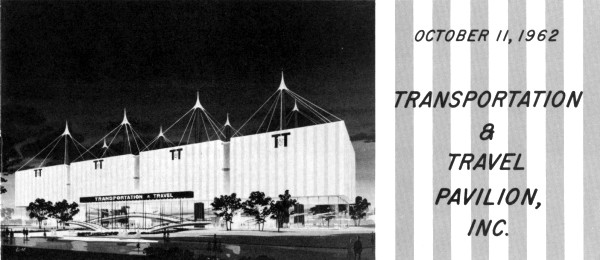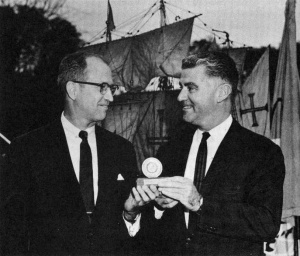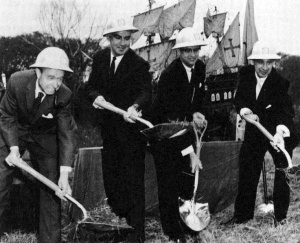|
GROUNDBREAKING AT THE
NEW YORK WORLD'S FAIR 1964-1965
 |
- The Transportation & Travel Pavilion,
as shown above, will cover an area 378 1/2 feet long and 183
1/2 feet wide. Entirely supported by eight steel pylons, each
120 feet tall, the steel and glass structure will glow as a huge
beacon in the night.
|
|
SOURCE: Groundbreaking
Brochure, The Transportation & Travel Pavilion
|
REMARKS BY TRANSPORTATION
& TRAVEL PAVILION AND WORLD'S FAIR OFFICIALS AT THE PAVILION'S
GROUNDBREAKING CEREMONIES, NEW YORK WORLD'S FAIR, THURSDAY, OCTOBER
11, 1962.
ROBERT O. THATCHER
[President of T. & T., Inc.]: Ladies and gentlemen, as president
of Transportation & Travel Pavilion, I welcome and appreciate
your being with us on this important day. I will skip over all
the hard work that has brought us to this date. Not to be overlooked,
however, is the faith and financial backing of many of you without
which this Pavilion would not have been possible.
With tongue in
cheek, I can say we are fortunate to have as our general contractor
one of the finest in New York, the Thatcher Construction Company.
We can also announce with pride the following key subcontractors,
and acknowledge their cooperation and interest in this great
project: Courter & Company, which will do the air-conditioning
work, is represented here by its president, Mr. Joseph Courter;
Ingalls Iron Works, which will do the structural and cable supports
is represented by Mr. Boykin; Lorson Electric Company, for electrical
work and lighting, is represented by Mr. Al Cooke; and Cayuga
Contracting Company for excavation, piling and foundations is
represented by Mr. Daniel Lazard, Stevens-Adamson will do the
moving ramps.
With this team
we expect a speedy completion of the project. In bringing the
Pavilion to this groundbreaking stage, I gratefully acknowledge
the help given us by Mr. Guy Tozzoli, director of the World Trade
Department for the Port of New York Authority and Francis Miller,
director of the Transportation section of the World's Fair. The
Port of New York Authority acts as agent for the Fair in the
Transportation area.
All the other
representatives of the World's Fair, headed by Mr. Moses, have
been most cooperative in helping us to solve the many problems
which arise in undertaking such a project of this nature. Foremost
among these many people has been a man on whose able shoulders
rests the full responsibility for communications and public relations
-- such an important part of a world's fair. To many of you he
needs no introduction -- Mr. William Berns.
WILLIAM BERNS:
Thank you Mr. Thatcher. We are particularly proud today to witness
the groundbreaking of this outstanding Pavilion which will be
in one of the busiest neighborhoods of the New York World's Fair
during 1964 and 1965. I think as we stand out here today, we
are particularly aware of the part that transportation and travel
plays in our lives. We witness the planes flying overhead and
realize that we are right in the geographical center and near
the population center of this great city -- very close to LaGuardia
airport, and just down the line from Idlewild Airport, insuring
that our anticipated 70 million visitors during the years of
the Fair will find their way here with great ease through every
means of transportation and travel.
For your information,
it has recently been estimated by a careful study that each hour
some 83,000 will be able to arrive by the various means of travel
to the New York World's Fair. We expect that many of them --
in fact, most of them -- will be right here where we are now
located, to see the glorious building which will rise at this
site.
On behalf of
the president of the New York World's Fair, Mr. Robert Moses,
I am here to make a presentation to Mr. Thatcher. The only reason
that Mr. Moses could not personally be here today is because
he is at the scene of other activities with which he has been
identified over his years of public service. He is up at the
great Niagara Power Project which, combined with the St. Lawrence
Power Project, makes the State Power Authority the leading power
producer in the country.
Mr. Moses is
up there for the ribbon cutting of the South Grand Island bridge,
and for the dedication and groundbreaking of the new North Grand
Island bridge. He has asked us today to present to Mr. Thatcher
the official medallion of the New York World's Fair commemorating
its basic purpose of PEACE THROUGH UNDERSTANDING. It is with
great pride and pleasure that we now present Mr. Thatcher with
this medallion.
|
- William Berns (right), Fair vice president
for Communications and Public Relations, presents official Fair
medallion to Robert O. Thatcher, president of the Transportation
& Travel Pavilion, Inc., during groundbreaking ceremonies.
 |
|
MR. THATCHER:
Thank you, Mr. Berns. By coincidence, this beginning of what
we expect to be one of the most brightly spotlighted stages in
this great show occurs on the eve of the anniversary of the discovery
of America. Tomorrow is Columbus Day -- a living memorial to
the greatest of travelers. Today we want to honor ourselves by
enrolling Christopher Columbus as the first and highest name
in in the Transportation Hall of Fame which will be a featured
exhibit in the Pavilion.
Columbus, pressing
forward into the unknown -- on a ship such as you see here on
my left -- launched the first great age of exploration. Viewing
now the whole sweep of progress since then, it is no disparagement
of the intervening
|
|
|
centuries to
point out that time has waited for the present -- our own day
-- to bring you the world's second great age of exploration,
and the instrument of this is transportation.
Our Hall of Fame,
an integral part of this building, will give recognition to the
men who have made possible this new age in man's restless history.
We invite the transportation industry to help select the pioneers
and heroes most deserving of this honor. We hope every agency,
corporation, institution and publication connected with transportation
and travel will contribute nominations for this honor role. After
this, we plan to have an industrywide poll of selection
presided over by an eminent committee.
The Pavilion
is designed to collect into a comprehensive sequence the varied
means by which man today takes himself and the works of this
hands wherever he cares to go. Here will be the vehicles and
safeguards by which he speeds himself and sends his products
around the earth, and into its most secret hiding places -- over
Mt. Everest and under the North Pole, with suburban outings ticketed
for the moon and Venus. Into this building will go the scientific
implements which the services of American private enterprise
have so lavishly created.
And here on these
walls will be honored the men who have led the way, who have
gone farther, fastest, first and most courageously -- those whose
organizing genius has created the means for going. You and I
-- average men and women -- now can follow them to the ends of
the earth in convenience and comfort.
A most startling
upsurge in transportation, as statistics seem to show, has taken
place in the interval between the two New York World's Fairs
from 1940 to the present. Looking at United States government
figures on personal consumption and expenditures, I find that
we Americans were spending at the time of the first Fair, in
round numbers, 7 billion dollars a year on transportation, and
twenty years later -- 40 billion dollars.
This vast and
growing industry, this dream come true of advancing mobility,
is the subject of this Pavilion. Here also will be exhibited
the alluring possibilities of travel for pleasure as well as
for profit and understanding. Here will be shown the leap from
a slow wagon train through Arkansas to transportation at any
speed, anywhere you desire to go.
We are proud
to be able to tell this story at the Fair. It is fitting that
at this point I ask one whose name will be foremost in our Hall
of Fame, to put the first shovel in the ground -- Major Alexander
P. de Seversky.
MAJOR DE SEVERSKY:
I am highly honored to be chosen on this historic occasion to
participate in the groundbreaking ceremony of the Transportation
& Travel Pavilion of this great Fair. I feel humble to find
myself among the great men who have been selected to be enshrined
in this Hall of Fame. Personally, in all humility, I must confess
the primary justification I find to use this shovel is my longevity.
I have had the
good fortune to experience as an active participant, all forms
of transportation up to but, unfortunately, not including the
orbital flights. As a boy, I drove to school in a horse and buggy.
Later, when I was a cadet in Naval Academy, I ran a railroad
locomotive as a part of my military training. Then came the automobile
and I became a goggle and duster man. As a naval officer, I got
a taste of sea when I skippered a destroyer.
In 1915 I received
my wings and became an aviator. I have been designing, building
and flying planes ever since. Incidentally, I still hold a commercial
pilot's license, flying jets, so you can see jet aircraft already
have become an old man's airplane. In the meantime, rocket propulsion
came into being and now man is finally able to overcome the pull
of gravity and invade space.
For every technological
advancement in transportation, travel time has been compressed,
and our planet proportionately shrunk. I must admit the pioneering
of my generation, romantic and exciting as it was, pales in comparison
to what is in store for us in the next decade. The marvels of
modern transportation today are only the beginning. Not only
will technology give us new forms of transportation, but it will
revolutionize those already existing.
|
|
In the not-too-distant
future, new and strange vehicles will rise a few feet above ground,
or the surface of the ocean, and will travel at great speeds
on a cushion of air. The same principle will revolutionize rail
transportation. A monorail utilizing aerodynamically compressed
air underneath its car will provide us with surface transportation
approaching the speed of sound.
Unique contraptions,
no bigger and no more complicated than a motorcycle, will propel
a person through the air with the greatest of ease. Eventually,
all transport aircraft will rise vertically and will travel at
supersonic speeds.
Guided ballistic
missiles, which now poise ominously for thermonuclear destruction,
will become the most reliable means of mail and
|
- Breaking ground for the Transportation
& Travel Pavilion are, left to right, Charles Stanton, William
Berns, Robert Thatcher, and Major Alexander P. de Seversky. Model
ship in background was present in honor of Christopher Columbus,
who will be listed in T. & T.'s Hall of Fame.
 |
|
|
|
parcel post delivery
in a few minutes, to any part of the world. During past centuries,
lack of transportation and communication was responsible for
the creation of artificial barriers among the peoples of the
world which led to friction, hostilities and war. With the progress
of modern transportation, men are able to exchange more freely
their ideologies and the products of their toil.
Thus the artificial
barriers that have created suspicion and distrust are crumbling.
Technological advances in transportation will force the world
to become a single neighborhood. What is a neighborhood? It is
a community of people who live virtually within sound of each
other, sight of each other, and walking distance of each other.
Through radio we are already in hearing distance of each other
wherever we are. Through the marvels of Telstar and other satellites
to follow, television will put us within the sight of each other
wherever we are.
And measuring
the distance in flying time of jet airliners, and supersonic
craft, we are within walking distance of each other. Once the
ideological impasse which plagues the world today has been resolved,
the exploration of the universe -- the spaces endless beyond
the gravitation of the earth -- will become the concerted effort
of all the peoples of the earth. Interplanetary transportation
will become a reality.
Thus the world
is destined to become a single neighborhood and the scourge of
war will be a thing of the past. This is why I feel that this
Pavilion and what it represents are of such great importance.
Thank you very much.
MR. THATCHER:
I think it's fitting, now that the ground has been broken, that
we have a few words from Charles Luckman Associates, our architectural
consultants, represented by Mr. Serge Petroff.
MR. SERGE PETROFF:
Ladies and gentlemen, first I'd like to extend greetings, and
also my regrets that Mr. Luckman could not be here today.
As a partner
in charge of the project in the office I will say a few things
about its origin and about its design in Mr. Luckman's absence.
Basically, we tried to design a building which would represent
transportation. obviously, we couldn't have a moving building
-- these things to have to stand still. We feel, however, that
we have created a building which will have a sense of movement
-- a building which will be suspended in air and give the effect
of not being securely fastened to the ground except for the interior.
The whole principle
of suspension will be used so that the total mass of this building
will really seem free of the ground. This is our objective and,
as our design has been developed, I think we will achieve it.
Internally, the
building has been organized to permit entrance through moving
ramps onto a bridge which will feed a moving staircase up to
the top floor. The visitors will then filter down through the
building, like a fountain over the exhibits, back to the first
floor and out. Basically, the designs are pretty well completed
and the excavation contract is almost completely written and
let. We were writing specifications this morning. This is how
fast we have to work to catch up to the work of Robert Thatcher
and Robert Moses.
|
|